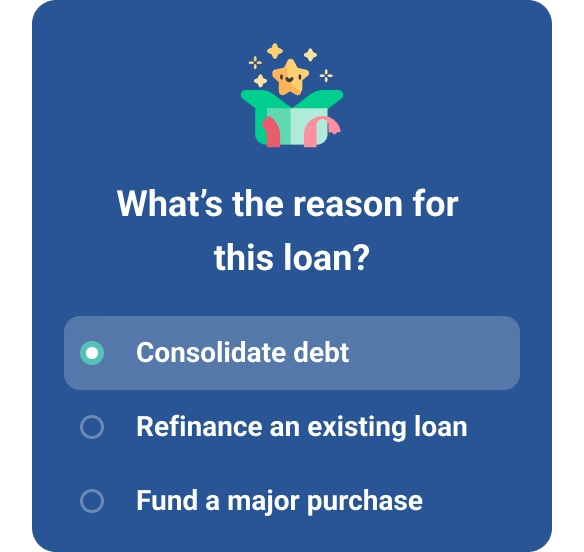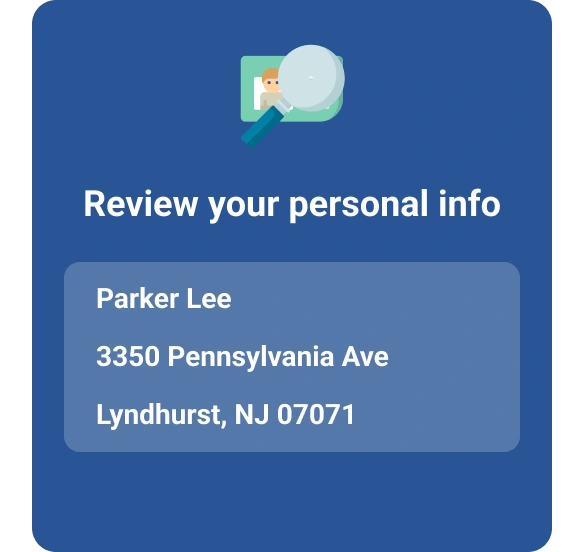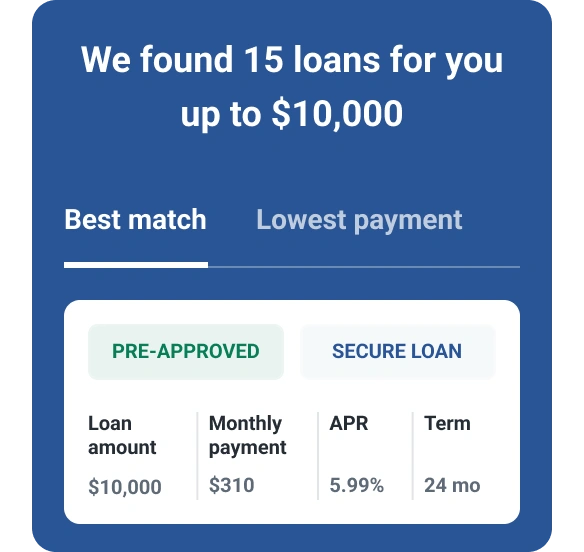What Is a Secured Loan?
Quick Answer
A secured loan is a type of loan backed by an asset such as a car or a house. Mortgages and car loans are examples of secured loans.

A secured loan is a type of loan that's backed by collateral, or assets you own. When you take out a secured loan, you're putting your collateral on the line. If you can't repay the loan, the lender can take your collateral to recoup their loss.
Because loans secured by collateral reduce the lender's risk, they allow borrowers to finance large purchases, such as a new home or vehicle. In addition, secured personal loans can be a flexible borrowing option with some advantages, such as lower interest rates. But secured loans also have downsides, and it's important to understand how they work and the risks they expose you to before you borrow. Here's what to know before you take out a secured loan.
How Does a Secured Loan Work?
A secured loan is a type of debt backed by collateral, such as physical assets like your house or car, or financial assets such as stocks and bonds. Secured loans are commonly used for large purchases. For example, if you use a mortgage to buy a home or an auto loan to buy a car, the loan is secured by the asset you purchased with it.
There are also secured personal loans, which work like unsecured personal loans but require you to back the loan with collateral. These types of loans can offer lower rates and easier approval, especially for borrowers with low credit.
If you have trouble paying the loan, the lender can put a lien on the secured loan's collateral. In the event that a borrower defaults on a secured loan, the lender can seize the collateral used to secure the loan. They can then sell it to cover any losses incurred on the loan. In the case of mortgages, this is called foreclosure.
Because the financial and personal consequences of defaulting on a secured loan are serious, it's imperative to understand what's at stake before you apply for a secured loan.
Types of Secured Loans
Secured loans can be used for a number of purposes, and there are many different loan products that use collateral. Here are a few of the most common types of secured loans:
- Mortgages, including home equity loans and HELOCs
- Auto loans and loans for boats, motorcycles and other types of vehicles
- Secured personal loans
- Secured credit cards
What Can Be Used as Collateral for a Loan?
Lenders often set specific requirements for what can be used as collateral on a secured loan. For example, in the case of a mortgage, your home will always serve as the collateral.
But other types of assets can be used as collateral, too, including:
- Real estate, such as your home
- Cash and financial accounts, including checking accounts, savings accounts, certificates of deposit accounts, and money market accounts
- Cars, trucks and other vehicles
- Stocks, mutual funds and bond investments
- Insurance policies, including life insurance
- Precious metals, high-end collectibles and other valuables
Secured vs. Unsecured Loans
The main difference between secured loans and unsecured loans is that an unsecured loan doesn't require you to put up any collateral to qualify. That major difference has other implications for how these types of loans work, who can qualify, the interest rate you'll pay and the consequences of missed payments.
Without collateral on the line, approval for an unsecured loan relies primarily on your credit report and score, your debt payment history and your debt-to-income ratio (DTI). Credit cards, student loans and personal loans are among the most common forms of unsecured loans.
| Secured Loan | Unsecured Loan | |
|---|---|---|
| Collateral required? | Yes | No |
| Interest rates | May be lower due to less lender risk | Generally higher than secured loans |
| Consequence of default | Loss of the collateral, as well as damage to your credit and possible fees | Damage to your credit, fees and debt collection |
| Common examples | Mortgages, auto loans, home equity loans and HELOCs, secured personal loans and secured credit cards | Credit cards, personal loans and student loans |
Pros and Cons of Secured Loans
Secured loans offer certain benefits that unsecured loans don't, but always consider the advantages and the risks of secured loans before you apply.
Pros of Secured Loans
- Easier to access: It can be easier for applicants with low or fair credit to qualify for a secured loan or a larger personal loan amount because the collateral mitigates some risk for the lender.
- More affordable: Secured loans tend to offer lower interest rates than a comparable unsecured loan because the lender takes on less risk. That said, review the individual loan's terms—some secured loans, such as car title loans, can have high rates.
- Build credit going forward: Borrowing a secured personal loan or using a secured credit card and managing it responsibly with on-time payments can help you build credit to qualify for other types of loans going forward.
Cons of Secured Loans
- Risk of losing assets: Getting a secured loan puts your personal property on the line. If you default on your secured loan, the lender can take your collateral.
- Risk to your credit: If you default on the loan and the lender takes your collateral, the repossession or foreclosure will remain on your credit report for up to seven years. Next to bankruptcy, foreclosure does the most damage to your credit.
- Lengthy underwriting process: Verifying the value of an asset is a lengthier process than simply running a credit check, so loans that use your assets for collateral often require substantially more time to go through review and get approved. As an example, getting approved for a mortgage can be time-intensive and requires appraisal and inspection.
What Happens if You Default on a Secured Loan?
The consequences of defaulting on a secured loan depend on how far you fall behind on your payments and on the specific terms of the secured loan you've borrowed. In general, missing a payment on your debt can result in lender-assessed late fees. Being at least 30 days late on a payment can result in a late payment showing on your credit report and damaging your credit score.
If you stop making payments on the loan altogether, the lender can seize your collateral. In most instances, the lender's repossession of collateral assets can remain on a borrower's credit report for up to seven years.
What sort of grace period you have between missing a payment and losing your asset depends on the terms of your loan contract. That's why it's imperative that you review the loan's terms before you apply, in addition to ensuring you can afford to repay the loan on time.
How to Avoid Default on a Secured Loan
If you're struggling to afford payments on your secured loan, act quickly to avoid missing payments. Here's how to avoid default if you start having trouble repaying your loan:
- Review your budget. The first step you should take if you're struggling to repay debt is to do a deep dive into your budget. Tally up your income and then review your basic expenses to determine the root of the cash flow problem.
- Reduce expenses. If your basic living expenses are putting you in the red, you'll need to find a way to reduce your cost of living, such as by lowering your bills. If your basic living expenses leave you with enough income to get by, then reducing your discretionary spending may be enough to free up funds and manage your debt. Cutting back can be a challenge, but make avoiding default your priority.
- Increase your income. If possible, look for ways to increase your income such as through taking on extra shifts or a side gig. Flexible work such as driving for a ride-hailing service or offering babysitting and pet sitting through an app may allow you to bring in spare cash around your current schedule.
- Contact your lender. Communication is key if you're at risk of falling behind on a secure loan payment. Make sure you reach out to your lender as soon as you realize you'll have a hard time making payments. They may be willing to offer you forbearance or offer another way to avoid the consequences of default.
- Seek credit counseling. If you're struggling to afford your debts, reach out to a nonprofit credit counselor. Credit counselors can help you review your finances and come up with a plan that works for you. They may help you manage your debt by budgeting, and in some cases, they may suggest a debt management plan.
The Bottom Line
A secured loan can help you borrow for a variety of goals, from buying a home or a car to covering a major expense. But these collateral-backed loan products also have substantial risks. As a borrower, it's important to weigh the risks against the benefits when considering a secured loan and ensure you have a strong plan and budget to repay the loan before you borrow.
When it comes to personal loans, a secured loan may be cheaper, but an unsecured loan won't put your property at risk. Consider other ways to save on personal loan interest rates. Start by checking your credit report and credit score for free through Experian.
If possible, take steps to improve your credit before you borrow. A higher score can broaden your borrowing options. Plus, it can reduce the rate lenders require you to pay in order to borrow.
Need a loan?
Whether you're shopping for a car or facing a last-minute expense, compare loan offers matched to your credit profile.
Start now for freeAbout the author
Evelyn Waugh is a personal finance writer covering credit, budgeting, saving and debt at Experian. She has reported on finance, real estate and consumer trends for a range of online and print publications.
Read more from Evelyn

